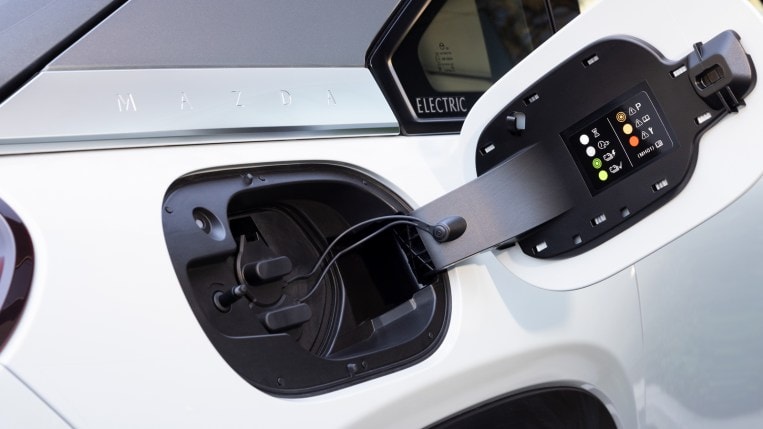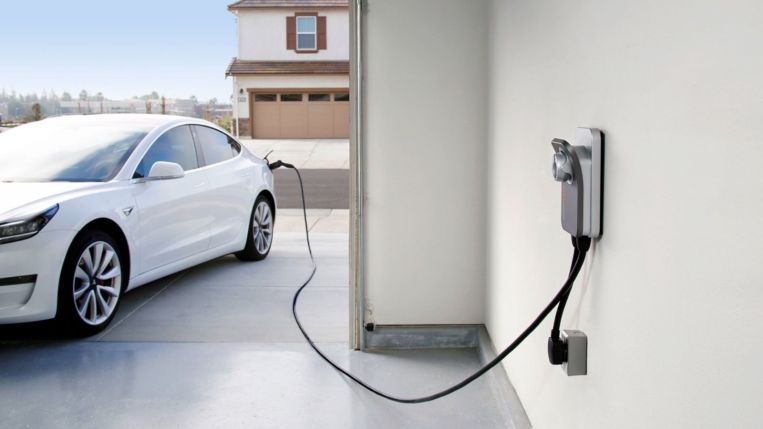[ad_1]

Along with the consideration of buying or leasing an electric vehicle is what type of EV charger you will use at home. As an EV driver, it’s a good idea to factor this plan into the cost of ownership. But first, you’ll need to find out about home charging. Where do you park your car? How many miles do you drive each day? Most importantly, how quickly would you like your car to charge up?
Another thing to consider is that the cost and convenience of EV battery charging times vary significantly based on your needs. The charger itself is a crucial part of the equation. The type of electric car battery, how much energy it can hold, and the level of battery depletion all play a role in the optimal time needed for charging. Even the ambient air temperature can impact the battery’s ability to accept a charge efficiently.
There are a variety of “plug-and-play” chargers that are ready for immediate use, while some require you to hardwire the installation. This guide will help you learn about the different types of electric car chargers and what features to look for when deciding on a charging system for your plug-in electric vehicle.
Level 1 and Level 2 EV Chargers: What’s the Difference?
The significant difference between Level 1 and Level 2 chargers is the rate of speed at which your EV or PHEV (plug-in hybrid electric vehicle) can charge. Level 2 charges up to 8 times faster than Level 1. The other big difference is price. For instance, the Level 1 charger is a cord that comes with the car, while Level 2 home charging stations usually cost an average of $2,000 for purchase and installation. But buyer beware: Installation can cost even more if your home does not meet the electrical requirements.
Another thing to know is that both Level 1 and Level 2 chargers connect to the SAE J1772 charge port equipped on all-electric vehicles except for Tesla models. Tesla, however, provides the adapter necessary for its cars to use this same J1772 charging port.
But before you decide which level is for you, consider the pros and cons of these different types of EV charging systems.
Level 1
These plugs use simple nozzle cords with a 120-volt regular plug.
- Pro: It’s free.
Level 1 chargers use a cord supplied to EV buyers when they purchase the vehicle. - Pro: You can plug it into a typical household plug.
This charging cord plugs directly into any standard outlet in your home. Most people’s garages or carports have these types of plugs readily available. As you’ll see below, Level 2 chargers can be expensive to install. - Pro: It’s great for PHEVs or low-mileage drivers.
These chargers work well for people who drive less than 30 miles per day. They also work for plug-in hybrid electric vehicles (PHEVs) that take less charge than a fully electric vehicle, known also as a battery electric vehicle (BEV). - Con: Level 1 is the slowest charger.
Level 1 chargers provide a “trickle charge” that charges the car very slowly, sometimes taking 11 to 20 hours for a full charge. It’s essential always to have a Level 1 charging cord with you when driving a BEV if you need to charge your car while away from home.
RELATED STORIES: How Long Does It Take to Charge an Electric Car
Level 2

Level 2 chargers operate on 240-volt power and can be installed at home.
- Pro: Faster charging.
In contrast, a Level 2 charger offers many advantages, including that it charges up to eight times faster than a Level 1 device, completing a full charge in only 3 to 8 hours. - Con: Level 2 requires a unique electrical setup.
However, the power it requires comes from a 240-volt plug, such as the one you would use for a dryer or other major appliance. You can also hardwire it directly into your electrical system. In most cases, installation requires an electrician to safely wire your garage or carport with this type of power. - Con: Costs.
Depending on the physical placement of the unit and the required power, it could cost anywhere between $400 and $4,500. These Level 2 charging units are a separate expense. They range in features and price, anywhere from $500 to $1,500. But even with this wide variety of potential costs, experts say to purchase and install these units costs an average of around $2,000. The bottom line: First, get the advice of an electrician to find out if a Level 2 charging station would be worth the expense of installation in your home. Next, find out if your electric utility offers any installation discounts, which may help defray some of the costs.
Level 3
Level 3 chargers use DC current for fast charging.
- Con: Commercial only — for now.
DC fast charging offers the fastest option. However, Level 3 chargers are typically only found commercially, including in public and Tesla charging stations. - Con: Needs too much power from home.
Due to its high voltage nature and the cost of installing a DC direct fast charger in your home, it’s not typically installed in a private home. Not all EVs offer fast charging, though most newer ones provide the software and combination socket that work with a DC plug.
Other Factors That Will Influence Your Choice
There isn’t a one-size-fits-all option for home EV chargers. Your particular situation will influence the type of setup you can have. Consider these factors when choosing a home charging station.
RELATED STORIES: How Much Does It Cost to Charge an Electric Car?
Safety and Protection for Animals and Children
- Electricity can be dangerous when misused or used with substandard equipment. When buying any EV charger, look for models that are UL certified. UL certified indicates that the nonprofit safety organization Underwriters Laboratory independently tested the charger. A product lacking this certification doesn’t mean that it is unsafe. But it does show that the charger did not undergo testing to demonstrate that it is safe for prolonged use.
- Keep children and pets away from charger plugs, connectors, and receptacles as with other electrical devices.
Inside (Garage) vs. Outside Charging
- Mounting a charging station on a garage wall will protect the unit from the elements. The interior location also provides a warmer temperature for better charging during the winter in colder regions. However, not every electric vehicle owner can park and charge their car inside.
- Many EV chargers come rated for outdoor use. Look for those with a higher rating from the National Electrical Manufacturers Association, or NEMA, for more protection from the weather. For example, a NEMA-4 rating unit is better protected from windblown rain and snow than a model with a NEMA-3 rating.
- Most charging stations come with holsters to protect the connector when not attached to the car. Whether it’s attached to the unit or a separate remote holster, using it will protect the plug from being damaged by precipitation and dust.
Hardwire vs. Plug-in EV Chargers
- EV chargers with greater power will charge the car faster, but those models may need to be installed by a qualified electrician.
- Chargers that deliver more than 40-amps must be hardwired. In other words, the unit connects directly to your power supply. This type of installation method is a more permanent option. If the charging unit has problems and needs replacing, an electrician must uninstall it and hook up the replacement.
- For plug-in Level 2 chargers, an electrician will need to install the electrical receptacle if a conveniently located 240-volt outlet isn’t available. However, this can cost less than hardwiring the unit. Other advantages of plug-in Level 2 chargers:
- Installation of the outlet can take place before your charger arrives.
- Replacing a faulty unit or upgrading to a different model is simple.
- Plug-in units can be removed and brought to another location, such as your second home.
Electric Panel
- One of the first questions a potential electric car owner should answer is whether they control their electricity supply. Permission from the homeowners’ association or landlord may require installing a charging station if you live in a co-op, condo, or apartment.
- Homeowners must determine if their existing electrical panel offers the capacity for a dedicated circuit for the charging station. A qualified electrician will assess your service panel to ensure it can sustain the needed electrical power.
- A circuit that can deliver at least 32-amps is required. Installing a 50-amp circuit will help ensure that the charger can provide 40-amps to your vehicle.
- Note that some jurisdictions may require that charging station installations comply with codes and regulations. Check with local authorities to find out if you need permits before installation.
Cable Length
- Ensure the cable that runs from your charging station to the car is made from rugged materials to provide shock protection and safety while charging in wet conditions.
- When shopping for chargers, pay attention to cable length, whether the location of the charging station will be inside or outside.
- Locate charge points on your family’s EV. Make sure your cable length can reach the connection. For example, a cable that’s less than 20-feet-long might be inconvenient because it would require you to park in a specific direction to plug into the charger.
Smart EV Chargers
“Smart” EV chargers are more advanced Level 2 products. They have features including Wi-Fi connectivity that enable users to engage a smartphone app for enhanced displays to track activity and schedule charging.
A popular feature on some smart chargers lets users enter their electric company information into their profile. The chargers generate reports for users to review statistics that calculate how much it costs to power the car. And by communicating with the utility, some smart chargers will avoid peak times and automatically charge during hours when the provider charges less for energy.
The additional expense of a smart charger isn’t worth it to every electric car driver. And for others, the features aren’t necessary for electric vehicle models. This includes the Nissan Leaf, which uses apps that function similarly to those offered by intelligent chargers.
RELATED STORIES: Electric Cars Coming in 2022
Wireless EV Chargers Coming Soon
In development at several car companies, wireless EV chargers are something to look forward to for charging electric cars. Hyundai’s luxury brand, Genesis, plans this feature as a factory-installed option on its GV60 electric SUV in 2023. Also touting this technology feature are Tesla, Ford, Volvo, Hyundai, and Kia.
The charging unit will consist of a power receiver on the vehicle, a wall box connected to the electric source, and a charging pad on the ground that connects to the box. A car will park directly over the charging pad to receive between 35 and 40 miles of range per hour of charging at about 11 kilowatts without using a nozzle.
Related Electric Car Guides:
[ad_2]
Source link







More Stories
How to Get the Most Cash for Junk Cars
Exclusive Car Detailing Services
Aftermarket Auto Parts: Boon or Bane?